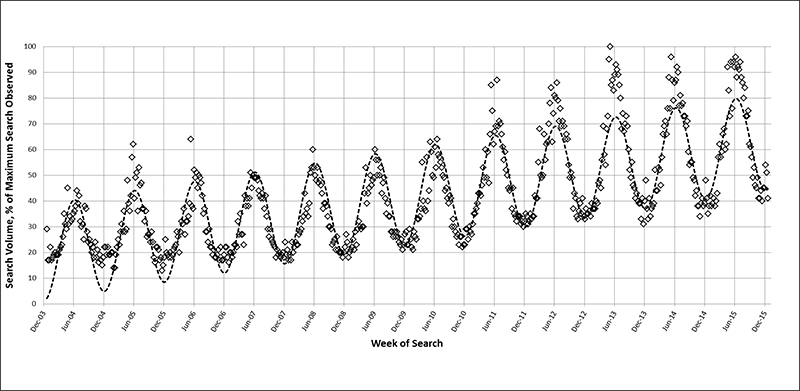
Drs. Scott Garrison (left) and Fangwei Liu.
Researchers resort to every innovative tool available to have more knowledge about human health and how to treat it. Probably most of us didn't think something like Google Trends could be one of the tools to guide family physicians everywhere.
Associate professor Scott Garrison and resident Fangwei Liu, both from the Faculty of Medicine & Dentistry's Department of Family Medicine, are the authors of this interesting study, recently published in the Annals of Family Medicine. It reviews Google searches in the United States from January 2004 to January 2016 and shows that people's searches for information on ankle swelling peak during summer.
The study also covered Australia's reversed seasons, where searches had the same pattern for summer.
Trends that answer doctors' questions
It all started with a previous study Garrison completed for his PhD about medications that could be causing leg cramps. He discovered then how useful it was to gather data on what the world was searching for to understand how symptoms change over time. The success of this study paved the way for finding patterns in health-related internet searches as a means to better understand those same conditions.
When Garrison was approached by Liu last year for a research project, he thought something with Google Trends would be a good start. He suggested investigating ankle swelling.
"I've been a family doctor for more than 20 years and most of those years were in full time fee-for-service family practice. So I've seen a lot of patients," says Garrison. "I'd noticed that every summer we saw several people coming in, complaining of ankle swelling. They didn't go on to develop vascular disease or any heart-related problems-which is important since ankle swelling can be a symptom of cardiovascular diseases such as venous stasis and congestive heart failure."
No literature described the summertime surge in apparently benign ankle swelling, so Garrison and Liu turned to Internet search volume to determine if it was a seasonal condition. Not only the numbers confirmed this theory, but other experienced family physicians agreed to have observed this phenomenon.
"I don't think anyone other than a family doctor would notice this. Specialists only see patients with diagnosed cardiovascular disease, and there's often a long delay between the symptom developing and the patient seeing them," explains Garrison.

There is a visible pattern for ankle swelling related searches, reaching their highest point around June and plummeting during winter. (Garrison/Liu)
He also finds this information especially helpful for younger family doctors, who haven't seen this trend yet in their practice and could benefit from knowing there may be a simple explanation for their patients' swelling. Liu agrees with him: "Knowing about the presence of certain trends can affect medical practice. Understanding that certain bloodwork values fluctuate throughout the year will prevent unnecessary visits for 'abnormal' results. Similarly, understanding that ankle swelling can have seasonal fluctuations may avoid expensive tests for patients without any pathology."
Unlike the summertime swelling Garrison and Liu describe, hospital admissions for congestive heart failure are more common in winter. However, it's always wise to see a doctor to confirm the cause of the swelling.
Seasonality is common in nature
According to Scott Garrison, seasonal conditions could be a proof that humans may have developed mechanisms to anticipate and cope with changes in the environment, just like other species.
"I find it fascinating that we generally assume that humans don't have any seasonality to their physiology. Many other mammals do-whether it's fur thickness, body fat or hibernating," he says. "Children grow more quickly in summer and the immune system is more aggressive in winter. It's possible that the same may be happening with ankle swelling, it could be to evolutionary advantage that you retain water during the warmer months in case it's not available to you."
So, what to do if you have swollen ankles? "You have to elevate your ankles above the level of your heart, essentially, to let the fluid drain out," advises Garrison. "If you're home at night, watching TV or reading, lie flat with your legs elevated. If you're sitting and you just place them on a footstool, the water won't drain out of your ankles."
Getting to the right measures
Fangwei Liu, U of A alumnus and second-year resident, thinks the methodology of their study opens new options to improve research for his area of medicine. "This type of research is an important first step in identifying the pattern of physiology and disease," he explains. "Also, observation of health trends is uniquely available to family medicine with longitudinal follow up of patient care."
The use of Google Trends has been a very helpful start for Liu. However, he sees the need to work around its limitations to get more data about the people making the searches. "I am definitely interested in other studies looking into trends," says Liu. "But while Google Trends has a lot to offer for this type of research, it requires further refinement to help identify any causality."
Garrison decided to continue working with data to improve primary care, from a different angle. "I'm interested in the timing of things. So we have other projects related to timing, but they're more related to whether time of day matters to different medications," he says.
Meet our partners
Dr. Scott Garrison is the director of the Pragmatic Trials Collaborative, a group that currently runs trials to answer vital questions about how to optimize the value of commonly used medications like warfarin. The group recently received Partnership for Research and Innovation in the Health System (PRIHS) funding from Alberta Innovates - Health Solutions to continue their work.